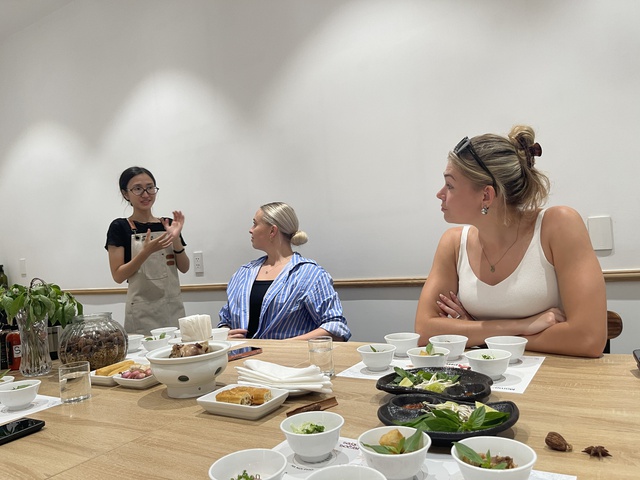
Hannah Prescott (right) and Emily Riby listen as host Minh Anh explains about 'pho.' Photo: Dong Nguyen / Tuoi Tre News
Inside an upstairs room on Ngo Duc Ke Street in Saigon Ward, Minh Anh, a staff member from Saigon Social, introduced one ingredient after another displayed neatly on the table.
In front of her, the foreign guests listened attentively, occasionally touching cinnamon, star anise, cardamom, and coriander seeds with curiosity.
When it came to the most important part, host Minh Anh passionately described the slow simmering of bones and the hours spent skimming to achieve a clear, aromatic broth — the soul of Vietnamese pho.
“You know, pho actually refers to this noodle,” Minh Anh explained, moving on to demonstrate how rice sheets are steamed and cut into strands, and how to test their freshness by chewing or gently pulling them apart.
Originally from the UK and now living in Singapore, Riby and Prescott were no strangers to pho.
Riby, who enjoys reviewing food, had already tried pho at several restaurants in both Singapore and Vietnam.
She was the one who persuaded her friend Prescott to join this tasting experience.
Still, this was their first time learning in depth about the ingredients and cooking process.
“I didn't know that pho was the noodle, I assumed it was the broth,” Prescott said.
Pho – a type of Vietnamese soup, usually served with rice noodles, slices of beef or chicken, and herbs, as defined by the Oxford Learner’s Dictionary – has gained global fame for its rich flavor and healthy balance.
Yet few people truly know about the dish’s many regional variations and the different ways it is enjoyed across Vietnam.
The pho tasting experience was an initiative of Singaporean food blogger Jovel Chan, who lives in Ho Chi Minh City.
She founded Saigon Social, a culinary community space where she and her partners host workshops and tastings that let foreign visitors explore Vietnamese cuisine through themes such as coffee, pho, and fish sauce.
“I’d had the idea for a pho tasting for quite some time, but it took a while to convince partners to provide tasting portions and agree on how we’d tell the story of the dish,” Chan told Tuoi Tre News.
According to her, although the program is still new, it has attracted strong interest from foreign visitors, many of whom were unaware of how diverse pho actually is.
Pho: one dish, many stories to tell
The highlight of the pho tasting session was sampling six different kinds of pho: Hanoi-style pho, Saigon-style pho, pho phong (crispy golden pho puffs), pho xao (wok-fried pho), pho cuon (fresh pho rolls), and pho kho Gia Lai (Gia Lai-style dry pho).
The dishes were served in small portions, not to fill the stomach but to showcase pho’s remarkable diversity.
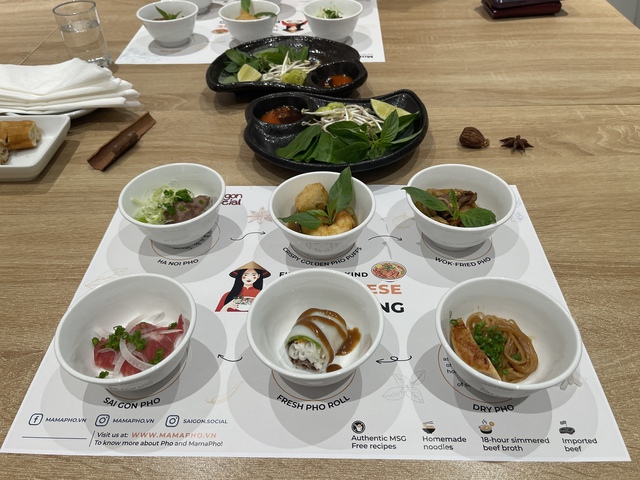
Six types of 'pho' by MamaPho were introduced along with their cooking methods, ingredients, and ways of eating at a 'pho' tasting session at Saigon Social. Photo: Dong Nguyen / Tuoi Tre News
Minh Anh explained the preparation, origin, history, ingredients, and serving styles of each variation.
The differences between the two most familiar versions — northern and southern pho — especially caught the participants’ attention.
The northern pho is light, usually served with scallions and a bit of chili sauce, while the southern variant features more toppings such as sliced onions, basil, culantro, bean sprouts, and sauces like hoisin and sa te (Vietnamese lemongrass and chilli oil).
The participants were fascinated to learn that crispy pho puffs are made from square-cut pho sheets stacked and fried until golden, while the refreshing pho rolls, dipped in creamy peanut sauce, offered a completely different texture.
Next came wok-fried pho, where the noodles are stir-fried with meat, vegetables, and spices, creating a fragrant, chewy dish.
Finally, Gia Lai dry pho, or also known as 'pho hai to' (two-bowl pho), which originated in Gia Lai Province, presented a distinct experience, with the noodles served separately from the broth.
“I'm surprised that there are so many versions of pho," Prescott commented.
A nutritionist herself, Prescott also enjoyed pho for its healthy qualities — a clear broth, beef for protein, noodles for carbohydrates, fresh herbs, and vegetables for balance.
At the end of the session, participants were quizzed with a few fun questions to test what they had learned.
Before leaving, Riby also asked for pho recommendations to try before flying back to Singapore, and to keep in mind for future visits to Vietnam.
Sixty minutes may not be enough to grasp every detail about pho, but the visitors left with newfound knowledge and a respect for the effort behind each bowl, and for the cultural significance this beloved dish holds in Vietnamese life.
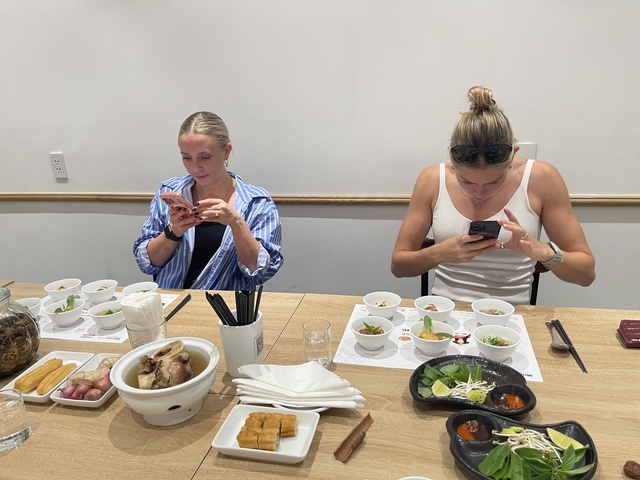
Hannah Prescott (right) and Emily Riby take photos of the different 'pho' versions during the tasting session. Photo: Dong Nguyen / Tuoi Tre News
The growing interest from foreign visitors in learning about pho’s history and regional styles reflects how the dish has evolved from a humble street food to a global symbol of Vietnamese cuisine.
This appreciation will continue to be celebrated at the upcoming Vietnam Phở Festival 2024 in Singapore on October 18 and 19, where visitors can enjoy authentic pho flavors, meet renowned chefs, and explore the cultural stories behind Vietnam’s beloved national dish.
Vietnam Phở Festival 2025: When Vietnamese 'pho' becomes a ‘cultural ambassador’ in Singapore
Vietnam Phở Festival 2025 in Singapore: Cultural connection, cooperation boost
The Vietnam Phở Festival is organized by the Vietnamese Embassy in Singapore, Tuoi Tre (Youth) newspaper, and Saigontourist Group, in coordination with the Ho Chi Minh City Department of Industry and Trade and the Vietnamese Community Liaison Committee in Singapore.
The event, which is held under the guidance of the Vietnamese Ministry of Foreign Affairs and the Ho Chi Minh City People's Committee, will take place on October 18 and 19 at Our Tampines Hub in the city-state.
The festival comes as Vietnam and Singapore have just upgraded their ties to a Comprehensive Strategic Partnership, underlining the event's timeliness and significance.
With the message 'Pho – Enjoying Together, Growing Together,' the Vietnam Phở Festival 2025 aims not only to invite international friends to enjoy Vietnam's iconic dish—listed by CNN in 2011 among the world's 50 must-try foods—but also to convey Vietnam's aspiration for connection, sharing, and growing together.
Through the festival, pho will be presented as a 'cultural ambassador,' a bridge fostering prosperity and sustainability between Vietnam, Singapore, and global friends.
The highlight of the event is offering Singaporeans and visitors the chance to savor authentic Vietnamese pho, freshly prepared by top Vietnamese chefs and culinary artisans at Our Tampines Hub.
Head chefs from five-star hotels under Saigontourist Group, including Rex Saigon, Majestic Saigon, Grand Saigon, Caravelle Saigon, and the pho restaurant of Vietnam Golf & Country Club, along with renowned pho brands such as Pho Thin Bo Ho, Pho Ta, Pho Phu Gia, Pho Vuong, and Ba Ban Pho, will showcase the diversity of pho recipes and styles of enjoyment.
Beyond pho, visitors can also enjoy a range of traditional Vietnamese dishes, prepared by Saigontourist's five-star chefs, creating a vibrant 'culinary symphony.'
Alongside the festival, a large-scale investment forum titled the 'Vietnam–Singapore Investment, Trade and Tourism Promotion Forum 2025' will take place, highlighting the event's practical significance.
The forum will kick off right after the opening ceremony on the morning of October 18 and is expected to attract around 150 enterprises from both countries.
At the forum, government agencies and businesses will discuss new cooperation trends in green processing industries and logistics, tourism and aviation services, the export and import of Vietnamese agricultural products and specialties, as well as digital transformation and e-commerce.
In particular, the Business Matching program (one-on-one business meetings) will facilitate direct connections between Vietnamese and Singaporean enterprises, helping them explore practical partnership opportunities.
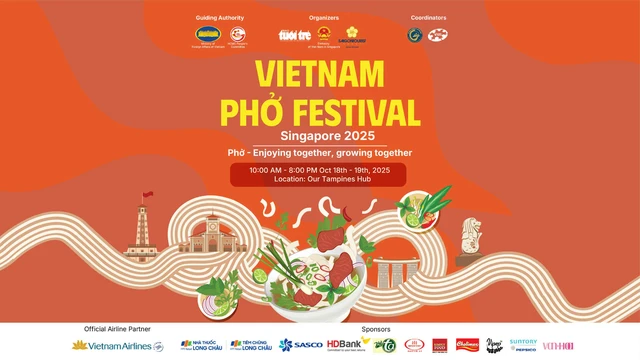


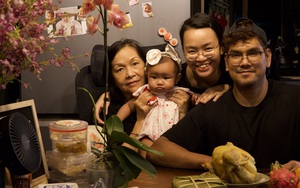

Max: 1500 characters
There are no comments yet. Be the first to comment.